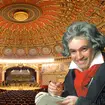Therese Malfatti (1792-1851) and Beethoven's Für Elise
Like Giulietta Guicciardi, Therese Malfatti was a pupil of Beethoven's, and - as with Giulietta - he fell in love with her and decided to propose marriage to her. His plans came to naught, probably because of an extremely embarrassing incident.
In the spring of 1810 he was invited to the Malfatti household in the Kärntnerstrasse for a soirée being thrown by Therese's father for all the family's friends and business acquaintances.
Beethoven had composed a short piano piece - Bagatelle WoO 59 - for Therese. His plan seems to have been to play it for her in front of the guests and propose marriage to her.
According to Gleichenstein in a letter home to his parents in Freiburg, Signore Malfatti served an exceedingly strong punch at the soirée - and Beethoven drank huge quantities of it.
So drunk was he that he was unable to play the piece, and in no condition to propose anything to anyone. It seems that Therese made him instead write her name on the title page.
He wrote, in almost illegible writing, "Für Therese".
On her death, the original manuscript was found in her effects. It was taken to a music publisher, who immediately recognised the notiation as being in Beethoven's hand and decided to publish it posthumously
He published it under the title Bagatelle, but apparently misread the dedication.
"Für Elise" appeared on the top of the title page, and the piece - quite possibly the most famous piano music Beethoven ever composed, probably because practically anyone can play it - has been known by that name ever since.
In 1816 Therese married a Hungarian count, Johann Wilhelm von Drosdick. He was born in 1771; the date of his death is not known, but it was after Therese's in 1851.




























